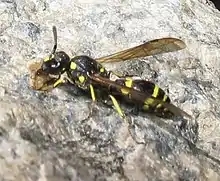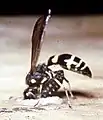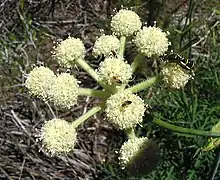Symmorphus cristatus
Symmorphus cristatus is a species of mason wasp in the subfamily Eumeninae within the family Vespidae. This species is widely distributed in North America, and it preys on the larvae of leaf beetles.[2]
| Symmorphus cristatus | |
|---|---|
 | |
| Symmorphus cristatus female carrying mud to nest | |
| Scientific classification | |
| Domain: | Eukaryota |
| Kingdom: | Animalia |
| Phylum: | Arthropoda |
| Class: | Insecta |
| Order: | Hymenoptera |
| Infraorder: | Aculeata |
| Superfamily: | Vespoidea |
| Family: | Vespidae |
| Subfamily: | Eumeninae |
| Genus: | Symmorphus |
| Species: | S. cristatus |
| Binomial name | |
| Symmorphus cristatus (Saussure, 1855) | |
| Synonyms[1] | |
| |
Description
Symmorphus cristatus is one of three Symmorphus species that occur in North America.[3][4] Viewed from above, the metasomal tergum is narrower than S. albomarginatus or S. canadensis, and it has smaller depressions (cephalic foveae) adjacent to the simple eyes (ocelli) that are spaced closer together than those of S. canadensis. The 'femur' portion of the hind legs has conspicuous hairs, which S. canadensis lacks.[5]
Wing length of S. cristatus ranges from 5.0-9.0mm, and body markings range from pale to yellow. Males are typically about 20% smaller than females, and males typically possess a large pale spot on the ventral part of the face (clypeus) just above the mandibles, whereas in females the spot is small or absent.[3][4]
Taxonomy
Eumenine wasps differ from other members of the Vespidae by the presence of a single spur on the middle tibia and a cleft in the 'tarsal' claw at the distal end of the legs. They generally possess three submarginal cells on the forewings and are solitary wasps, in contrast to social vespids that build communal nests.[5] Within the Eumeninae, Symmorphus wasps lack a 'petiole' or elongated first abdominal segment,[5] have a furrow on the dorsal side of the anterior abdominal segment (metasomal tergum).[6]
Distribution
Symmorphus cristatus is widely distributed across Canada from the west to the east coast.[4][7] It is also found in northern regions and mountainous regions in the United States.[8][9][10][11] In California, populations are known in the Sierra Nevada from Inyo to Siskiyou County and in the San Francisco Bay Area.[2]
Ecology
Symmorphus cristatus belongs to a lineage of 'trap-nesting' solitary wasps in which adult females forage for immature insects to provision a nest,[6] usually found in a pre-existing hole in a tree or log.[11] This 'renting' behavior may have evolved from nest-builders or nest-burrowing wasps; most species in the Eumeninae are either renters or builders, and most of these provision their nests with immature Lepidoptera (butterflies or moths) or beetles.[3][5] Like other Eumeninae, S. cristatus uses mud or clay to construct nests where larvae are provisioned.[6]
 S. cristatus female exiting the nest
S. cristatus female exiting the nest S. cristatus female completing her nest
S. cristatus female completing her nest S. cristatus female with a beetle larva
S. cristatus female with a beetle larva
Symmorphus wasps are known to use chrysomeline beetle larvae as prey worldwide.[12][13][14][15][16] These beetle larvae usually possess external secretion glands from which they evert volatile compounds that are considered anti-predator defenses,[17][18] but the wasps have little difficulty foraging for them,[2] stinging them to immobilize them,[19] and provisioning each wasp larva with several prey individuals within a cell bounded by a layer of clay or mud.[11][2] Known prey of S. cristatus include Gonioctena americana,[8] Chrysomela scripta,[8] Chrysomela crotchi,[8][7] Chrysomela aeneicollis,[2][20] Chrysomela schaefferi,[2] and Plagiodera californica.[2] The prey use of the wasps indicates that they are not repelled by either the host-plant derived secretions found in Chrysomela larvae or by autogeneously synthesized defensive secretion found in P. californica.[2]
Symmorphus cristatus nests may be subjects of brood parasitism by the cuckoo wasp Chrysis nitidula, as observed by Krombein[11] in eastern North America and observed for populations in the Eastern Sierra Nevada in California.[2]
 Logepole pine with S. cristatus nests
Logepole pine with S. cristatus nests Pine log with S. cristatus nests
Pine log with S. cristatus nests S. cristatus nests and 7 mm wasp traps
S. cristatus nests and 7 mm wasp traps Filled S. cristatus nests in log
Filled S. cristatus nests in log Chrysis nitidula near a S. cristatus nest in Big Pine Creek, CA
Chrysis nitidula near a S. cristatus nest in Big Pine Creek, CA
Symmorphus wasps are considered major mortality factors influencing populations of several species of leaf beetles.[14][15][7] An ecological study on relative importance of different predators on Chrysomela aeneicollis revealed that S. cristatus and the specialist fly predator Parasyrphus melanderi had complementary effects on beetle larval survival, with P. melanderi exerting more predation pressure on eggs and young beetle larvae and S. cristatus exerting a greater effect on mature (third instar) beetle larvae,[21] upon which they specialized.[2]
Habitat

These wasps are likely to be found where there are adequate floral resources for adults,[20][10] where adequate dead trees or logs can be found for their nests,[11] and where the chrysomelid beetle larvae used to feed larval wasps can be found.[6][1] In Illinois, adult S. cristatus wasps were documented on flowers of diverse plants.[10] In the eastern Sierra Nevada mountains, adults can be observed on flowers feeding on nectar of plants in the Apiaceae, such as fennel (Foeniculum vulgare),Queen Anne's lace (Daucus carota), cow parsnip (Heracleum maximum) and swamp whiteheads (Angelica capitellata), also known as ranger's buttons.[2] Females tend to make nests in holes that are approximately 5 mm,[9][22] and in the eastern Sierra Nevada, they are frequently found in lodgepole pine (Pinus contorta) trees or logs.[2][20]
References
- Cumming, J. M. (1989). "Classification and evolution of the Eumenine wasp genus Symmorphus Wesmael (Hymenoptera: Vespidae)". Memoirs of the Entomological Society of Canada. 148: 1–168. doi:10.4039/entm121148fv.
- Sears, Anna LW; Smiley, John T; Hilker, Monika; Müller, Frank; Rank, Nathan E (2001). "Nesting behavior and prey use in two geographically separated populations of the specialist wasp Symmorphus cristatus (Vespidae: Eumeninae)". The American Midland Naturalist. 145 (2): 233–246. doi:10.1674/0003-0031(2001)145[0233:NBAPUI]2.0.CO;2. hdl:10211.1/796. S2CID 6122463.
- "66. Symmorphus cristatus (de Saussure, 1855)". Symmorphus cristatus (de Saussure, 1855). Retrieved 2021-06-18.
- "Symmorphus cristatus {species} - Arthropoda; Insecta; Hymenoptera; Vespidae; Eumeninae; Symmorphus". The Barcode of Life Data System. Retrieved 2021-06-19.
- Buck, Matthias; Marshall, Stephen A.; Cheung, David KB (2008). "Identification Atlas of the Vespidae (Hymenoptera, Aculeata) of the northeastern Nearctic region". Canadian Journal of Arthropod Identification. 5 (1): 1–492.
- Carpenter, J. M.; Cumming, J. M. (1985). "A character analysis of the North American potter wasps (Hymenoptera: Vespidae; Eumeninae)". Journal of Natural History. 19 (5): 877–916. doi:10.1080/00222938500770551.
- Smereka, E. P. (1965). "The life history and habits of Chrysomela crotchi Brown (Coleoptera: Chrysomelidae) in northwestern Ontario". The Canadian Entomologist. 97 (5): 541–549. doi:10.4039/Ent97541-5.
- Krombein, K. V.; Hurd, P. D.; Smith, D. R.; Brooks, B. D. (1979). A catalogue of Hymenoptera north of Mexico. Vol. 2. Washington D.C.: Smithsonian Institution Press.
- "National Pollinator Week". The Michigan Nature Guy's blog. 2016-06-20. Retrieved 2021-06-19.
- "Insect Visitors of Illinois Wildflowers". Insect Visitors of Illinois Wildflowers. Retrieved 2021-06-18.
- Krombein, K. V. (1967). Trap nesting wasps and bees: life histories, nests, and associates. Washington, D.C.: Smithsonian Press.
- Budriene, A. (2003). "Prey of Symmorphus wasps (Hymenoptera, Eumeninae) in Lithuania". Acta Zoologica Lituanica. 13 (3): 306–310. doi:10.1080/13921657.2003.10512686.
- Schmidt, K.; Schmid-Egger, C. (1991). "Faunistik und Ökologie der solitären Faltenwespen (Eumenidae) Baden-Württembergs". Veröffentlichungen Naturschutz Landschaftspflege Baden-Württenbergs. 66: 495–541. Richards, O. W. (1980). Handbook for the identification of British Insects: Soliodea, Vespoidea, and Sphecoidea. Vol. 7. London: Royal Entomological Society of London.
- Devantoy, J. (1948). "Les Prédateurs et les parasites de la chrysomèle du peuplier". La Feulle des Naturalistes. 3 (8): 85–89.
- Rank, N. E.; Smiley, J. T.; Köpf, A. (1996). "Natural enemies and host plant relationships for chrysomeline leaf beetles feeding on Salicaceae". In P. H. Jolivet; M. L. Cox (eds.). Chrysomelidae Biology. Vol. 2: Ecological Studies. Amsterdam: SPB Publishing. pp. 147–171.
- Blüthgen, P. (1961). Die Faltenwespen Mitteleuropas (Hymenoptera, Diploptera). Berlin: Akademie Verlag.
- Pasteels, J. M.; Braekman, J. C.; Daloze, D. D.; Spencer, K. A. (1988). "Chemical defense in the Chrysomelidae". In P. Jolivet; E. Petitpierre; T. H. Hsiao (eds.). Biology of Chrysomelidae. Vol. 42. Dordrecht, The Netherlands: Kluwer. pp. 233–260.
- Pasteels, J. M.; Rowell-Rahier, M.; Raupp, M. J. (1988). "Plant-derived defense in chrysomelid beetles". In P. Barbosa; D. K. Letourneau (eds.). Novel aspects of insect-plant interactions. New York: Wiley. pp. 235–271.
- Budriene, A.; Budrys, E. (2004). "Hunting behaviour of predatory wasps (Hymenoptera : Vespidae : Eumeninae): is the distribution of stinging effort phylogenetically inherited or dependent on the prey type?". Annales de la Société Entomologique de France. 40 (3–4): 259–268. doi:10.1080/00379271.2004.10697424. ISSN 0037-9271. S2CID 56085176.
- Smiley, J. T.; Rank, N. E. (1986). "Predator protection versus rapid growth in a montane leaf beetle". Oecologia. 70 (1): 106–112. Bibcode:1986Oecol..70..106S. doi:10.1007/BF00377117. PMID 28311293. S2CID 24472517.
- Otto, S. B.; Berlow, E. L.; Rank, N. E.; Smiley, J.; Brose, U. (2008). "Predator diversity and identity drive interaction strength and trophic cascades in a food web". Ecology. 89 (1): 134–44. doi:10.1890/07-0066.1. hdl:10211.1/799. ISSN 0012-9658. PMID 18376555.
- Rank, N. E. (1994). "Host plant effects on larval survival in a salicin-using leaf beetle Chrysomela aeneicollis (Coleoptera: Chrysomelidae)". Oecologia (Berlin). 97 (3): 342–353. doi:10.1007/BF00317324. PMID 28313629. S2CID 20569239.